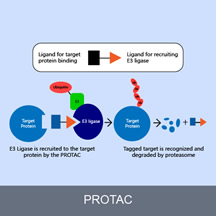What are PROTACs in drug discovery?
In the ever-evolving landscape of drug discovery, scientists and researchers are continually seeking innovative approaches to develop more effective and targeted therapies. One such groundbreaking technology making waves in the field is PROTACs, or Proteolysis-Targeting Chimeras.
1. The Essence of PROTACs:
1.1 Proteolysis-Targeting Chimeras Defined:
PROTACs are a class of small molecules designed to induce the targeted degradation of specific proteins within cells. Unlike traditional drugs that aim to inhibit protein function, PROTACs leverage the cell's own machinery to degrade the target proteins.
1.2 Dual-Targeting Architecture:
PROTACs consist of a bifunctional structure with two binding moieties—one that binds to the target protein of interest and another that binds to an E3 ubiquitin ligase. This dual-targeting architecture facilitates the recruitment of the target protein to the cellular degradation machinery.
2. Mechanism of Action:
2.1 Engaging the Ubiquitin-Proteasome System:
Once the PROTAC binds to both the target protein and the E3 ligase, it facilitates the transfer of ubiquitin molecules to the target protein. This ubiquitination signals the protein for degradation by the proteasome, a cellular recycling system.
2.2 Selective Protein Degradation:
The specificity of PROTACs lies in their ability to selectively degrade the target protein while sparing other non-target proteins. This precision enables a more nuanced and targeted approach compared to traditional inhibition methods.
3. Advantages Over Inhibition:
3.1 Complete Removal of Target Proteins:
Unlike inhibitors that temporarily block protein activity, PROTACs lead to the complete removal of the target protein from the cell. This can be advantageous in diseases where overexpression or malfunctioning proteins contribute to pathology.
3.2 Potential for Broader Therapeutic Targets:
Additional resources:Unveiling the Power of Hydroxypropyl Methylcellulose in Skincare
10 Best Paintbrushes for Walls: Brushes vs. Rollers vs. Sprays
What are the sectors of the cosmetic industry?
What are the primary uses of Hydroxy Ethyl Cellulose (HEC)?
Iron Oxide Pigment: The Ultimate Guide to Application Techniques
What Are Specialty Gases Used forPROTACs have the potential to target a broader range of proteins, including those previously considered "undruggable" using traditional inhibition approaches. This expands the scope of therapeutic possibilities in various diseases.
4. Applications in Drug Discovery:
4.1 Oncology:
PROTACs have shown promise in oncology by targeting specific proteins implicated in cancer development and progression. This includes proteins involved in signaling pathways, transcription factors, and other cancer-related targets.
4.2 Neurodegenerative Diseases:
In neurodegenerative diseases, where abnormal protein aggregation is a hallmark, PROTACs offer a novel strategy to degrade disease-associated proteins, potentially slowing or halting disease progression.
4.3 Immunology and Inflammation:
PROTACs have potential applications in modulating immune and inflammatory responses by targeting specific proteins involved in these processes. This opens avenues for developing therapies for autoimmune diseases and inflammatory disorders.
5. Challenges and Future Directions:
5.1 Delivery and Pharmacokinetics:
Like many emerging technologies, the successful implementation of PROTACs in clinical settings faces challenges related to drug delivery and pharmacokinetics. Ensuring effective delivery to target tissues and understanding how PROTACs behave in the body are ongoing areas of research.
5.2 Optimizing Efficacy and Specificity:
Researchers are actively working to enhance the efficacy and specificity of PROTACs. This involves optimizing the design of these molecules, including refining the linker structures and improving the selectivity of binding moieties.
PROTACs represent a revolutionary approach in drug discovery, offering a paradigm shift from traditional inhibition strategies. Their ability to selectively and completely degrade target proteins opens new possibilities for treating diseases with previously limited therapeutic options. While challenges remain, ongoing research and advancements in PROTAC technology hold the promise of unlocking innovative therapies for a wide range of medical conditions. As scientists delve deeper into the intricacies of PROTACs, the potential to reshape the landscape of medicine and improve patient outcomes becomes increasingly evident.


